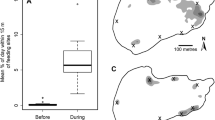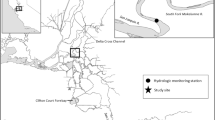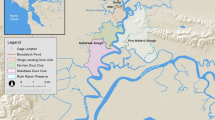Abstract
The growth rates of two fish species, the winter flounder Pseudopleuronectes americanus (Walbaum) (19.3 to 42.6 mm total length, TL) and the tautog Tautogaonitis (Linnaeus) (23.9 to 55.9 mm TL), were used to evaluate habitat quality under and around municipal piers in the Hudson River estuary, USA. Growth rates were measured in a series of 10 d field caging-experiments conducted at two large piers in the summers of 1996 and 1997. Cages (0.64 m2) were deployed along␣transects that stretched from underneath the piers to beyond them, encompassing the pier edge (the transitional zone between the pier interior and the outside). Growth in weight (G w ) was determined at five locations along the transect, 40 m beneath the pier, 20 m beneath the pier, at the pier edge, 20 m beyond the pier edge, and 40 m beyond. Under piers, mean growth rates of winter flounder and tautogs were negative (x¯G W = −0.02 d−1), and rates were comparable to laboratory-starved control fishes (x¯G W = −0.02 d−1). In contrast, mean growth rates at pier edges and in open waters beyond piers were generally positive (x¯G W ranged from −0.001 to +0.05 d−1), with growth at pier edges often being more variable and less rapid than at open-water sites. Analyses of stomach contents upon retrieval of caged fishes revealed that dry weights of food were generally higher among fishes caged at open-water stations (x¯ range = 0.02 to 0.72 mg dry wt) than at pier-edge (x¯ range = 0.01 to 0.54 mg) or under-pier (x¯ range = 0.03 to 0.11 mg) stations, although it was apparent that benthic prey were available at all stations on the transect. Our results indicate poor feeding conditions among fishes caged under piers, and suboptimal foraging among fishes caged at pier edges. Inadequate growth rates can lead to higher rates of mortality, and, based on these and other earlier experiments, we conclude that under-pier environments are poor-quality habitats for some species of juvenile fishes.
Similar content being viewed by others
Author information
Authors and Affiliations
Additional information
Received: 12 March 1998 / Accepted: 9 November 1998
Rights and permissions
About this article
Cite this article
Duffy-Anderson, J., Able, K. Effects of municipal piers on the growth of juvenile fishes in the Hudson River estuary: a study across a pier edge. Marine Biology 133, 409–418 (1999). https://doi.org/10.1007/s002270050479
Issue Date:
DOI: https://doi.org/10.1007/s002270050479




